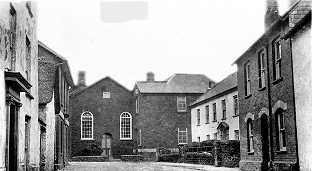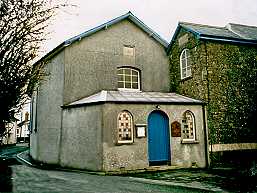

|
The first Bible Christian services in Witheridge were held in the house of Robert Turner in Tracey Green, but with the purchase of a cob and thatch barn in West Street on the 28th March 1855 from local farmer, John Cole, the "Bible Christians" had their first chapel in Witheridge. £40 more enabled the building to be converted into a "neat little sanctuary" measuring 28 foot by 16 foot room, filled with wooden pews, and with a small pulpit in the left hand corner. The building was settled on a trust deed for "The People called Bible Christians," and there were seven trustees, only two of whom actually lived in Witheridge. The deed made it perfectly clear what the chapel was for. The trustees were to permit such persons as were appointed by Conference, and no others except local Bible Christians "Duly appointed according to the rules of the said Denomination," with the consent of the superintendent of the circuit, "To enjoy the said Premises in order that they may therein preach and expound God's Holy Word and perform all other acts of Religious Worship." In 1859, it became apparent that the existing chapel in Witheridge was to small, and that a larger chapel would be needed. The two cottages adjoining the chapel were purchased, and demolished to make room for a church twice the size of the one opened four years earlier. The members worked hard, none more so than Mrs Clapp and Mr and Mrs Gill of Foxdon, and on Thursday 23rd June, 1859 the present Methodist Church in Witheridge was opened for divine worship at a cost of £220. The preacher at both services held on that day being Rev. Frederick William Bourne the noted Bible Christian minister.
The Methodists now had a worthy home in Witheridge, there was seating for 180 persons, and the building was "generally pronounced a handsome structure." In his report of the opening of the present chapel, the superintendent names three persons "To whose exertions the building of the chapel is largely to be attributed." They were Mrs Clapp and Mr and Mrs Gill. Mrs Clapp was a widow who held a small school for girls at a house now called "Belmont" near the square. Mr and Mrs Gill lived at 'Foxdon' a farm about one and a half miles from Witheridge. They were both members of society, and gave liberally to the funds of the church. Little is known about the other members of the church at this time. It is known that among the congregation were to be found many labourers, amongst them Mr and Mrs Heywood, Mr and Mrs Hodge, Mr and Mrs Hill, Mr and Mrs Woolway, Mr and Mrs Phillip, Mr and Mrs Sowden, and many others. Mr Chapel a tailor, Mr Smale a grocer, and Mr Bulled a wheelwright also attended the new chapel. In 1903, the schoolroom was built at a cost of over £300. By the 1920's, the large choir was in demand for concerts in the area. 1931 saw the installation of the electric light, and in 1935, electric heaters replaced the stove. In 1936 £309.10s was spent on alterations to the Methodist Chapel. The wall at the back was rebuilt, and the old railings, red brick wall and bushes by the doorway were replaced by a glass-covered porch giving access to the chapel and schoolroom. The re-opening was attended by, among others, the Chairman of the Exeter District A brief recent history of Witheridge Methodist Church and an outline of hopes and plans for the future In 1998 the situation for Witheridge Methodist Church seemed bleak. Sunday morning congregations had shrunk to about 10 worshipers. A recent survey on the building indicated the need for major repairs. The fellowship began to think that the days of meeting for worship at the chapel could be coming to an end. It was decided that the chapel would close and the fellowship would meet elsewhere.
This happened for one Sunday. Suddenly everyone felt that this was not the right way forward. It seemed wrong to withdraw from the centre of Witheridge where the chapel was ideally placed to serve the community. So the fellowship resolved two things. First, the existing building, as a historic place of worship must be restored to a condition fit for public use. Second, this must spring from a vision among the Methodist people to use the building in order to serve the community. The aim would be to make the chapel more "user friendly" so that it can accommodate a diversity of activities, providing a meeting place for all ages and taking into account the need for disabled access. The Methodist people experienced a fresh sense of vision and decided to draw up a scheme and begin raising the financial resources. The last five years have been very exiting. The congregation has doubled in size. Local support in raising funds for the building scheme has been tremendous. At the time of writing applications are being made to various national bodies for grants and it is hoped that the work will soon commence. When the building work is complete it is hoped that the premises will be equipped to serve all ages in the community, not just on Sundays but throughout the week. The Methodist people have enjoyed working more closely with the Anglican and Congregational churches of Witheridge in recent times, and look forward to an ever-deeper partnership in the years ahead. Revd Russell HerbertMethodist Minister (1999 to the present day) Born in Witheridge, John Chapple entered the Bible Christian Ministry in 1834, where he volunteered for missionary work in the United States, and spent six years in Ohio before joining the Canadian ministry. He served as President of the Canadian Conference in 1858. Source: Oliver Beckerlegge, United Methodist Ministers and their Circuits 1797-1932 (1968) Previous Last Edited 03/07/2006 Copyright © 2000-2006 Witheridge Unless otherwise indicated on the page in question, the photographic images reproduced on this site belong to the Witheridge Archives, and, as such may not be reproduced for commercial purposes without written permission. However, you are welcome to use any of the photographs belonging to the archive for personal and/or non-commercial use. Any material shown as not being owned by the archive may not be reproduced in any form without first receiving written permission from the owner of the material in question. |



